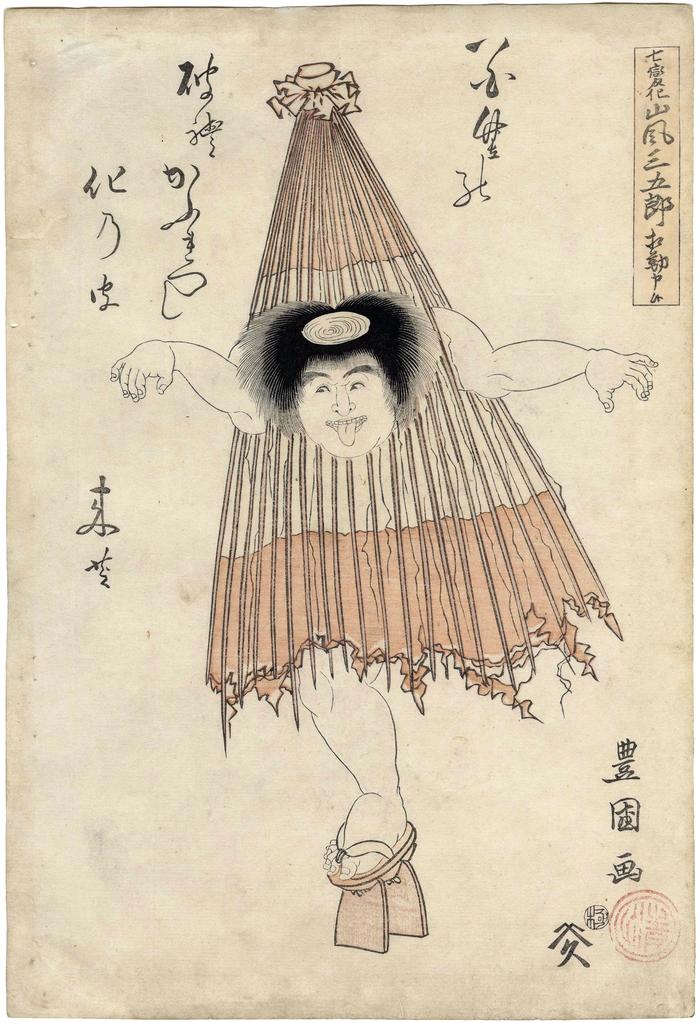Utagawa Toyokuni I (初代歌川豊国) (artist 1769 – 02/24/1825)
Umbrella monster (kasa-obake 傘おばけ or karakasa-obake から傘おばけ) from the series Seven Changes: Arashi Sangorō III... (Shichi Henge Sangorō - 七変化嵐三五郎)
03/17/1815
10.25 in x 15 in (Overall dimensions) Japanese woodblock print
Signature: Toyokuni ga
Publisher: Yamamotoya Heikichi (Marks 595 - seal 04-007)
Ritsumeikan University - another print from same series, but dated 3/17/1815
Museum of Fine Arts, Boston - an 1857 Toyokuni III composition which includes an ippon ashi
Museum of Fine Arts, Boston - another composition from 1857 by Toyokuni III including an ippon ashi
Waseda University - another possible print from this series, date 1815
Hankyu Culture Foundation - another print from this series Arashi Raishi II held the name of Arashi Sangorō III from the 11th lunar month of 1797 to the 1st lunar month of 1823.
Kasa-obake (傘おばけ) are mythical ghosts (yōkai 妖怪) in Japanese folklore. They are sometimes, but not always, considered tsukumogami (付喪神), a tool which becomes imbued with living spirit after long use. They are also called "karakasa-obake" (から傘おばけ), "kasa-bake" (傘化け), and "karakasa kozō" (唐傘小僧).
****
This character is also referred to as an 'Ippon ashi no obake' (壱本足ノお化) or one-legged ghost.
****
Ihara Saikaku (1642-93) wrote a comical story about a possessed umbrella, Karakasa no go-takusen (傘の御託宣). In the tale, an umbrella falls to earth in a rustic part of Japan that had never seen an umbrella. Shades of 'The Gods Must Be Crazy". The local population doesn't know what to make of it and start worshiping it. When a spirit enters the umbrella it calls on the villagers to provide it with a beautiful maiden to serve it, but no young girls will agree to do this. A sexually active widow says she will serve the umbrella's needs. She waits all night for it to come to her, but it never arrives. Out of anger or frustration she destroys the umbrella. And the moral is....? We haven't a clue, but enjoy the tale all the same.
****
Illustrations and text in Rain and Snow: The Umbrella in Japanese Art by Julia Meech, Japan Society Inc., #92, p. 118. There is a full-page color reproduction on page 46 and another small black and white one on page 118.
Meech wrote on p. 118:
"The humorous seventeen-syllable poem (senryū) inscribed on this print is signed by Raishi, the poetry name of the actor Arashi Sangorō III (d. 1833). He inherited the poetry and stage name Raishi from his father and was known at the end of his career as Arashi Raishi II. The poem reads:
Hanagasa noA one-legged umbrella monster with a long tongue appeared on the scene with the surge of ghost plays in the early 19th century. This print documents a performance in which Sangorō came onstage as a tattered bangasa in the course of a Kabuki dance comprising seven costume changes (shichi henge). The knee of Sangorō's retracted left leg is just visible under the rim of the umbrella. One of the properties in a seven-costume performance was either a hat or an umbrella covered with flowers... the word hanagasa describes both.
yabure-kabure ya
bake no kawa
My flower umbrella
tattered and worn -
in the guise of a monster!
This umbrella demon has a depression on his head, suggesting that he is doubling as a kappa, another nasty goblin from Japanese folklore... Kappa need the depression to hold water, which is essential to their survival. One of the their unpleasant habits is sucking the liver of a victim out through his or her anus."
****
There is another copy of this print in the Kupferstich-Kabinett, Staatliche Kunstammlungen, Dresden.
Yūrei-zu (幽霊図 - ghosts demons monsters and spirits) (genre)
Yamamotoya Heikichi (山本屋平吉) (publisher)
Arashi Sangorō III (三代目嵐三五郎: from 11/1797 to 1/1823) (actor)
